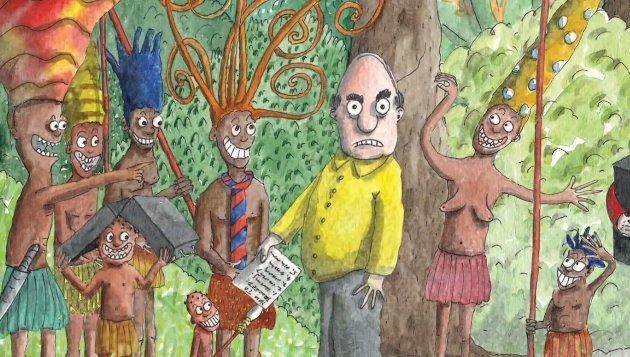Even my cousin Amos doesn’t want to wear strange hats in the jungle, says Uncle Tom.
Cousin Amos has researched his African ancestry and found out that he is really an Agyemang-Addo from Ghana. He now walks around in those flowing shirts that he buys when he goes all ghetto in 125th Street in Harlem. He also gets his dreadlocks maintained there. It costs him a lot of money but it makes him happy and that’s what counts. But when I saw him last week at Aunt Flora’s birthday he was pretty angry.
He had discovered an international organisation that is portraying ‘our ancestors’ as if they were retarded, he said, furiously chomping away at Aunt Flora’s carrot cake. “But the cake is pretty good”, I said, because cousin Amos gets angry and discovers conspiracies a lot, and I don’t always want to listen. He rolled his eyes at me and went to talk to Kenyan artist Wangechi Mutu, who is Aunt Flora’s friend, and she was laughing, so I got interested again and joined them.
The subject was Survival International, an organisation in the UK that protects indigenous people. I had never heard of them but Amos had found their website whilst surfing African pre-colonial history. He had discovered that they are quite wealthy and powerful and internationally ‘protecting’ people, from the Amazon tribes to the Bushmen in Botswana. I was surprised to hear that he was so angry, because our ancestors used to be just like that, indigenous people, until the whites came and enslaved us and colonized them of course.
“But we were never stupid sheep!” shouted cousin Amos, almost spilling his milk tea and wagging his finger, and he asked if I had seen a certain cartoon they made of ‘our people’. I said no and he showed it to me on his I Phone. It was indeed really weird. The cartoon was supposed to be ‘satirical’, but I could not say what it was ‘satirical’ about. It was about these child-like happy people in the jungle who were wearing very big and strange and high-piled hats. I must confess I dreamed off for a few seconds there, wondering how practical such hats would be in a place full of branches and leaves. I paste the link here so you can see it too.
But the happiness and the hats were not the only puzzling thing. The ‘satirical’ voice was now lambasting white people (the white people in the cartoon were supposedly the target of the ‘satire’, but they looked like normal white people to me) for bringing development to the jungle. It said that the brown people in the strange hats didn’t want roads and schools and factories, they were happy exactly as they were. They didn’t even want to earn more than a dollar per day, the voice said.
That was the strangest thing of all. If I know anything about the world, it is that people generally do want to earn more than a dollar per day. I did get the point that ‘development’ is not really development when the people who are supposed to be developing don’t get a say, but that is not what the cartoon said. The cartoon said that only white people want change and new things and that indigenous people can always eat fruit. It said that ‘they’ don’t need money and school, that ‘they’ are happiest in their little cabins. That’s what the old slave masters told my ancestor, the late, first, Uncle Tom, too.


